Ohio is home to just shy of one hundred and twenty caterpillar species. It’s not uncommon to encounter caterpillars from mid to late summer. Caterpillars are moth and butterfly larvae, feeding on tree, plant, and shrub leaves. The type of host plant the caterpillar is feeding on is determined by the species.
While we cannot list every single one of the caterpillars you can encounter in Ohio, we have compiled a list of the most common species, helping you identify them easily.
Table of Contents
Are Ohio Caterpillars Poisonous
Yes, there are poisonous caterpillars in Ohio and knowing them can help you reduce the risk of being injected with their toxic venom. You don’t want to accidentally touch one of these caterpillars, as they may result in itching, a rash, burning, or swelling. Always seek medical attention if you come into contact with a poisonous caterpillar.
The majority of problems that people encounter with poisonous caterpillars are due to their hairs, spines, or quills. The spines and hair are connected to toxin glands. When the hair or spines come into contact with your skin, you can experience blisters, swelling, itching, pain, and burning.
It is best to follow the rule that many animals follow. If you see a brightly-colored caterpillar with bristles, spines, or a fuzzy appearance, take it that it should not be touched. Knowing what caterpillars to avoid can reduce the risk of being stung by their hairs or bristles.
It is not easy to always avoid coming into contact with poisonous caterpillars, as the majority hide under leaves. The best option is to wear gloves when you are gardening to reduce the risk of the caterpillar’s hair coming into contact with your skin.
Symptoms of a caterpillar sting when you come into contact with its hairs or spikes include pain, itching, and a rash. Blistering and swelling may occur. If you get the poison in your eyes, it can cause serious eye irritation.
If you have been stung by a caterpillar, then remove it with care and put tape over the exposed area. Pull up the tape to remove any spines or hairs. Repeat with clean tape as often as needed to ensure all hairs or spikes are effectively removed.
Wash the area with soap and water. If you encounter itching, make a paste of baking soda and water and apply it to the area, you can also get hydrocortisone cream to apply from your local pharmacy.
If this doesn’t help, then you may need to visit the doctor for an antihistamine cream or tablets. In some cases, your health provider may give you a tetanus injection.
31 Common Caterpillars in Ohio
The most common caterpillars you may encounter in Ohio include:
1. Monarch Caterpillar

The Monarch Caterpillar (Danaus plexippus) goes through five growth stages, each growth stage lasting around five days, depending on food availability and temperature.
In the first growth stage, the caterpillar will hatch from the egg and is a light green or gray-white. They are shiny with a large black head. The caterpillar eats the eggshell and then starts to feed on milkweed in a circular motion.
As they age, they develop dark stripes with bumps. The second growth stage sees the caterpillar take on a pattern of yellow, black, and white banding. There is a yellow triangle on the head and yellow bands around the triangle. Black tentacles start growing. They are usually only around one centimeter in length at this stage.
In the third growth stage, the Monarch caterpillar has distinct banding and longer tentacles. They can be around 1.5 centimeters and feed in a cutting motion on the edge of the host plant leaf. The fourth stage sees white spots developing near the back.
They develop complex banding with white dogs in the fifth stage. They chew a notch in the petiole of the leaf, which causes the leaf to fall into a vertical position. They can be up to 4.5 centimeters in the fifth growth stage.
They become very aggressive in the fourth and fifth growth stages due to less food available. Caterpillars are attacked that are feeding on or searching for milkweed leaves. When they are fully grown, they are monarch butterflies, one of the most familiar butterflies in Ohio. The butterfly is easily recognizable with white, black, and orange wing patterns.
2. Eastern Tiger Swallowtail Caterpillar

The young Eastern Tiger Swallowtail Caterpillar (Papilio glaucus) is brown and white and changes color as it gets older. When they are mature, they are green and have an orange and black false eye spot, which gives them a snake-like appearance, helping to deter predators.
These caterpillars eat the leaves of the host plant. They rest on the leaf and the edges of the leaf fold over them, tied together with silk. They are brown in the first three growth stages with a large saddle on the abdomen.
They turn green in the fourth growth stage with black and orange eye spots on the swollen thorax. There is a black and yellow stripe on the first and second abdominal segments. They turn dark brown just before they pupate at a length of 5.5 centimeters.
This is a very common butterfly in Ohio and is often seen from spring until fall. Adults are excellent pollinators, feeding on a variety of flowers. Males are yellow with tiger stripes on the forewings. Females are yellow or black.
3. Pearl Crescent Caterpillar

The Pearl Crescent Caterpillar (Phyciodes tharos) is gray to dark brown with cream stripes and branched spines. They are gregarious feeders and become solitary as they age.
This caterpillar turns into a butterfly, common in Ohio in open areas, including pastures, vacant lots, parking lots, and pastures. They grow into beautiful butterflies with orange wings with black borders. They can grow to 3cm in wing span.
The adult butterfly feeds on the nectar of a host of flowers, including winter cress, dogbane, milkweed, and shepherd’s needle. The caterpillars feed on the leaves of the host plants and hibernate in the third growth stage.
4. Black Swallowtail Caterpillar
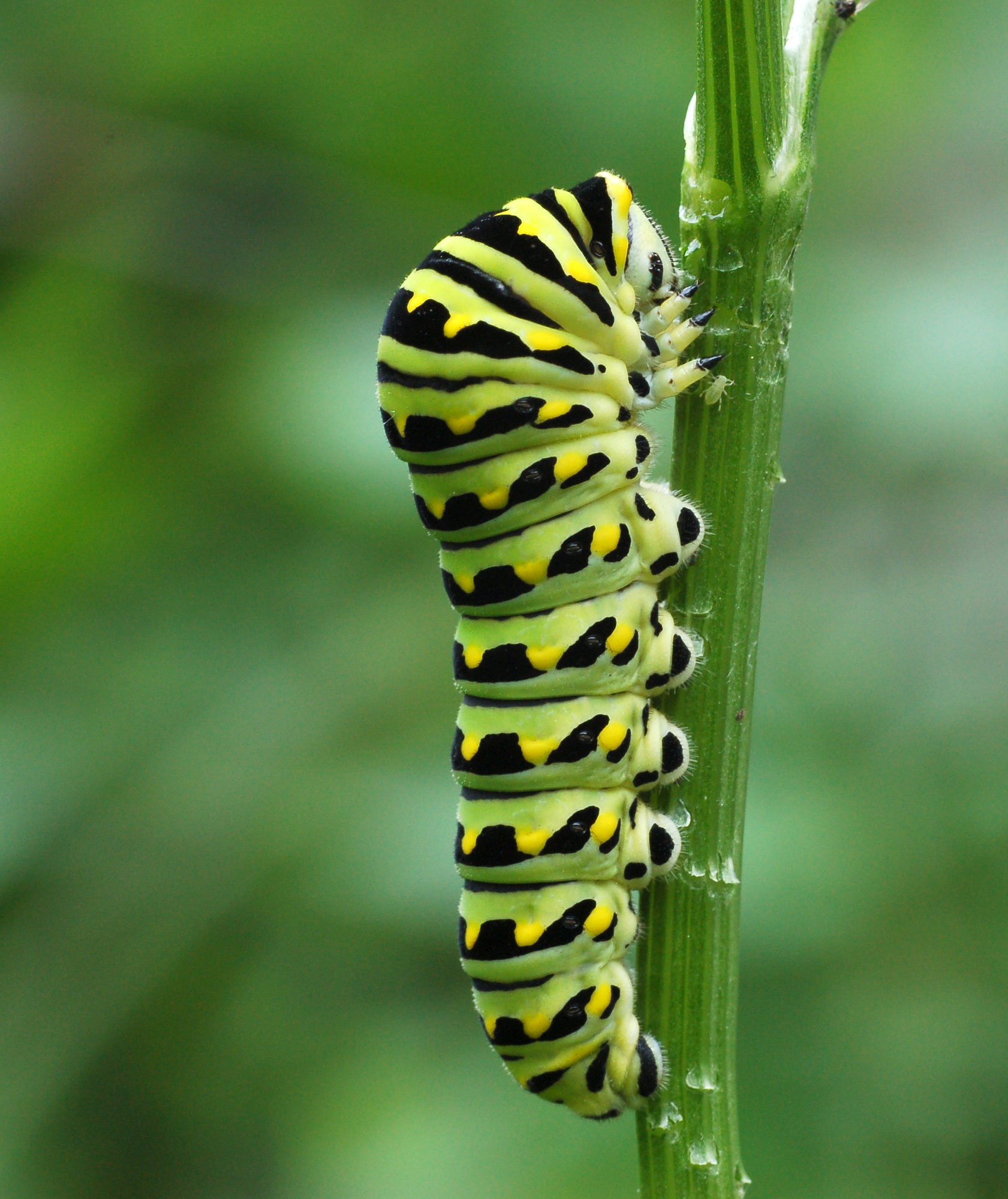
The young Black Swallowtail Caterpillars (Papilio polyxenes) look like bird droppings. They are dark brown with a white saddle. As they age they become bright green with yellow dots and black dashes. Their coloration helps them camouflage into their environment.
These caterpillars absorb the toxins from the host plant, giving them an awful taste to predators. The caterpillar has an orange gland, known as an osmeterium. When they are in danger, the osmeterium looks like a snake tongue, releasing a foul odor to deter predators.
Pupae are green or brown. Green pupae turn darker in color at the end of the pupae stage. This can happen a day or only a few hours before hatching.
5. Small White Caterpillar

These are green caterpillars (Pieris rapae) with a light yellow line over the top of the body. You can see fine white hairs, which release chemicals to ward off ant predators. The caterpillar’s growth is determined by temperature. They grow faster in higher temperatures.
In Ohio, these caterpillars are known as the imported cabbage worm. They are blue-green with black pints and a black ring around each spiracle. There is a row of yellow dashes and a yellow middorsal line.
The caterpillars rest under the leaves, hiding them from predators. When they first hatch through to the third growth stage, they have black heads. A green-yellow dot appears behind the eyes in the fourth and fifth growth stages.
These caterpillars are common cabbage, broccoli, horseradish, and kale pests. They are considered serious pests for commercial growers of cabbage. When fully matured, they are medium-sized butterflies. They are white butterflies with black dots on the wings.
6. Banded Woolly Bear

Banded Woolly Bear Caterpillars (Pyrrharctia isabella) have thirteen segments. The body is brown or black. Some are black at both ends and have a rust-color in the middle. While they do have hairs on their bodies, they do not inject venom and do not cause swelling and irritation. It is advisable not to touch them as the spiny hairs can cause dermatitis in those with skin sensitivities.
This is a tiger moth, first described in 1797, and a common yard visitor in Ohio.
7. Red Admiral Caterpillar

The Red Admiral Caterpillar (Vanessa atalanta) grows to around 2.5 centimeters in length. They vary in color, though the majority are black with white spines and spots. The spines are present through to the pupal stage.
The pupal period is determined by outside temperatures. The higher the temperature, the shorter the pupal period. The pupae are scarlet at higher temperatures and black in cooler temperatures.
The caterpillars prefer stinging nettles, though they can be found on false nettles. Once mature, they are a butterfly with black wings and an oblique band with white spots. The hind wing has a red margin and small black spots
8. Red-spotted Admiral Caterpillar

The Red-spotted Admiral Caterpillar (Limenitis arthemis) feeds on aspen, poplar, and willow trees. As adults, they emerge as a butterfly, common in Ohio. They have been studied for their wing patterns with a dramatic example of hybridization.
The fully grown caterpillars grow to around 1.6 inches with a brown head and short spines. They have olive green bodies with a white saddle and lateral line. There are branched horns on top of the prothorax.
When young, they resemble bird droppings and are the only horned caterpillars to mimic bird droppings to deter prey.
9. Viceroy Caterpillar

Viceroy Caterpillars (Limenitis archippus) feed on the willow family, including willows, poplars, and cottonwoods. The caterpillars have salicylic acid in their body, making them bitter and unappealing to predators. These caterpillars resemble bird droppings through all the growth stages, which offers them protection against predators.
These caterpillars are green or brown with cream blotches and two horns on the thorax. When they are partially grown, they spend their winter in a rolled leaf. The chrysalis is shiny white and brown with a pale abdomen. They have a large knob-like projection and still resemble bird droppings.
The caterpillars are often found in wetland areas, close to willows. As fully grown adults, they are common North American butterflies.
10. Ailanthus Webworm
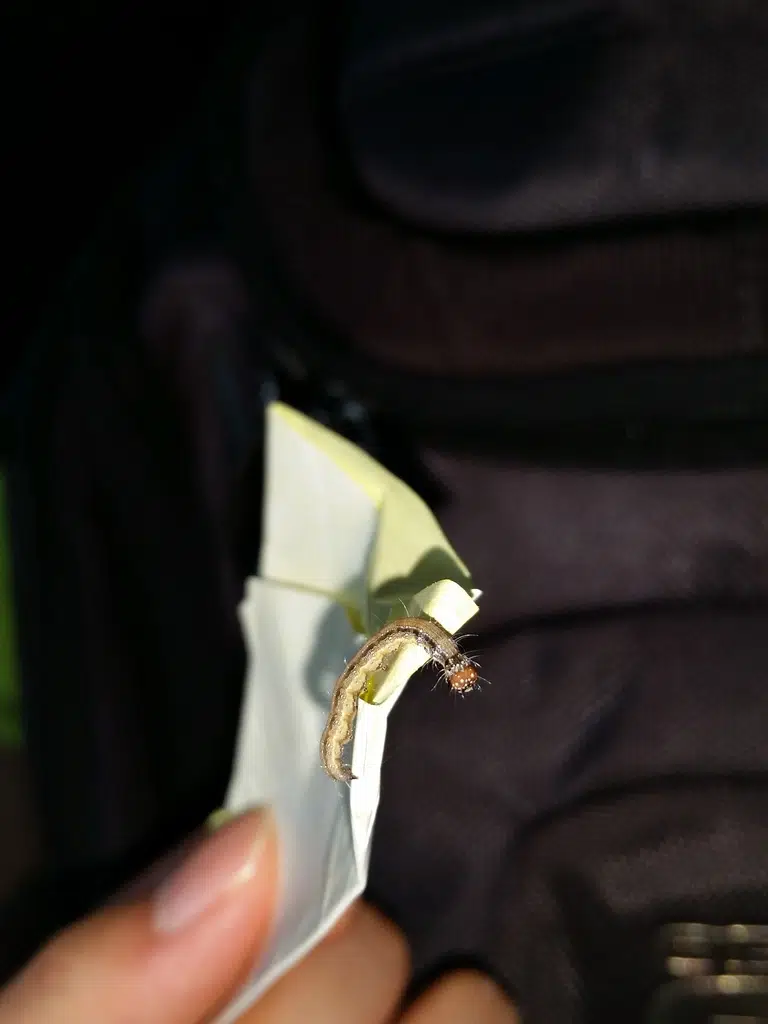
This caterpillar (Atteva aurea) has a wide stripe down its back and several thin lines. The wide stripe is green-brown, while the thin stripes alternate in olive-green and white. They can range in base color from dark black to light brown.
When fully grown they are a common Ohio moth. A small and colorful moth that resembles a beetle when resting and a wasp when in flight.
11. Spicebush Swallowtail Caterpillar

The Spicebush Swallowtail Caterpillar (Papilio troilus) resembles bird droppings when young, helping camouflage them against predators. They transform into brilliant green caterpillars with large false eye spots taking on a snake-like appearance to deter predators.
These caterpillars spin silk around a host plant leaf, which gives the caterpillar a place to hide during daylight hours, coming out at night to feed.
When they first hatch, the caterpillar chews through the edge of the leaf. They use silk on the midrib of the leaf. When the silk dries it contracts to encourage the leaf to fold around the caterpillar to create a shelter.
Young caterpillars are brown and if disturbed give off a foul odor. They turn green-yellow in the later stages, just before pupating. They leave their shelter when it’s time to pupate, moving closer to the ground.
12. Hickory Tussock Moth Caterpillar
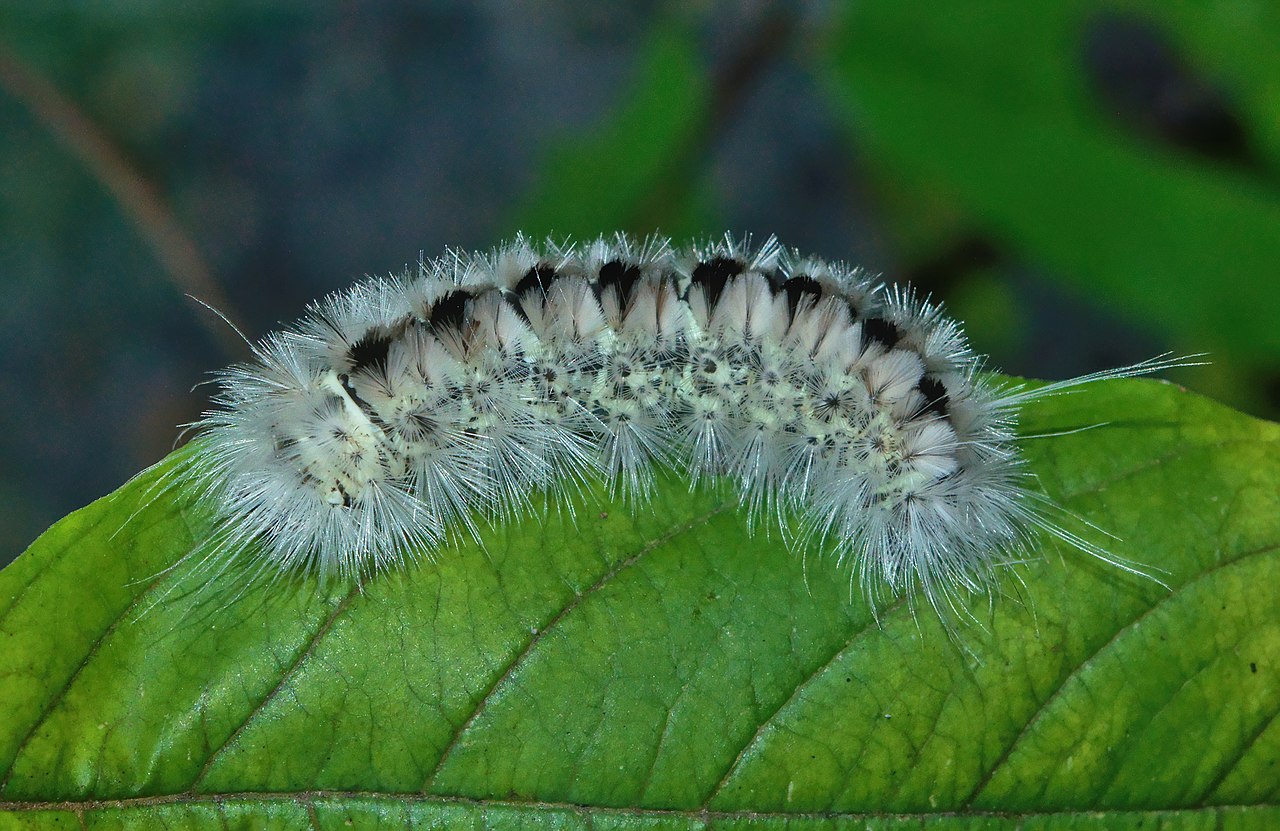
The Hickory Tussock Moth Caterpillar (Lophocampa caryae) is fuzzy in appearance. They are black and white and common in the fall. They are often seen in large numbers. Their hairs are known to irritate humans.
The young caterpillars are white with white hair and black spots. As they grow they are covered in black and white hairs, which are in tufts along their backs. Once in adult form, they are tan or light brown moths with cream spots in rows on the wings.
13. Eastern Comma Caterpillar
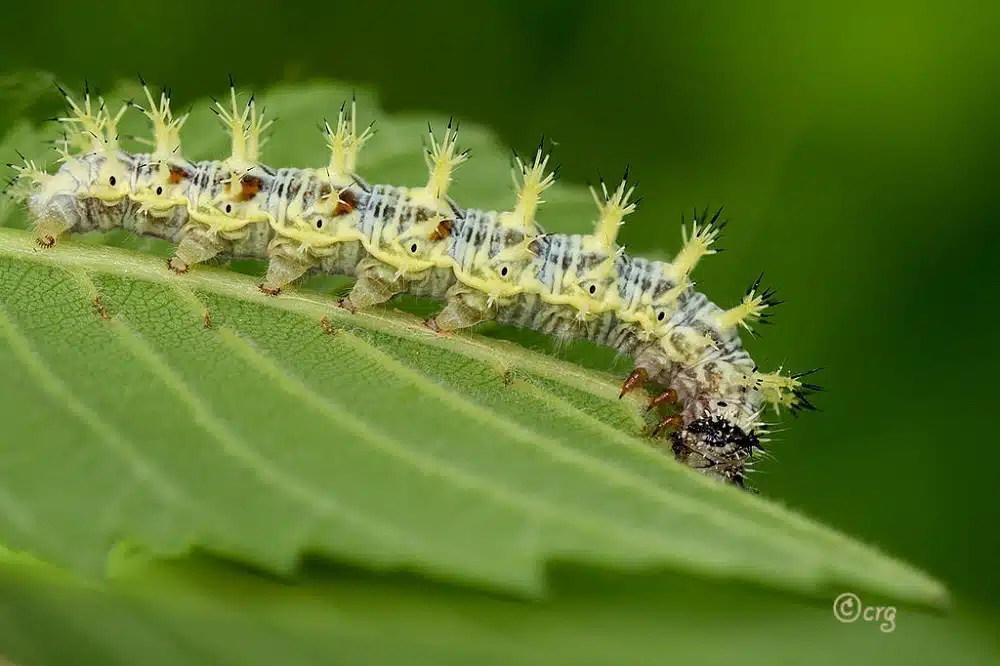
The Eastern Comma Caterpillar (Polygonia comma) is common in Ohio, often found on the meadowsweet plant. They are not dangerous to humans. They vary in color from green-brown to black with white banding and branched spines.
14. Common Buckeye Caterpillar
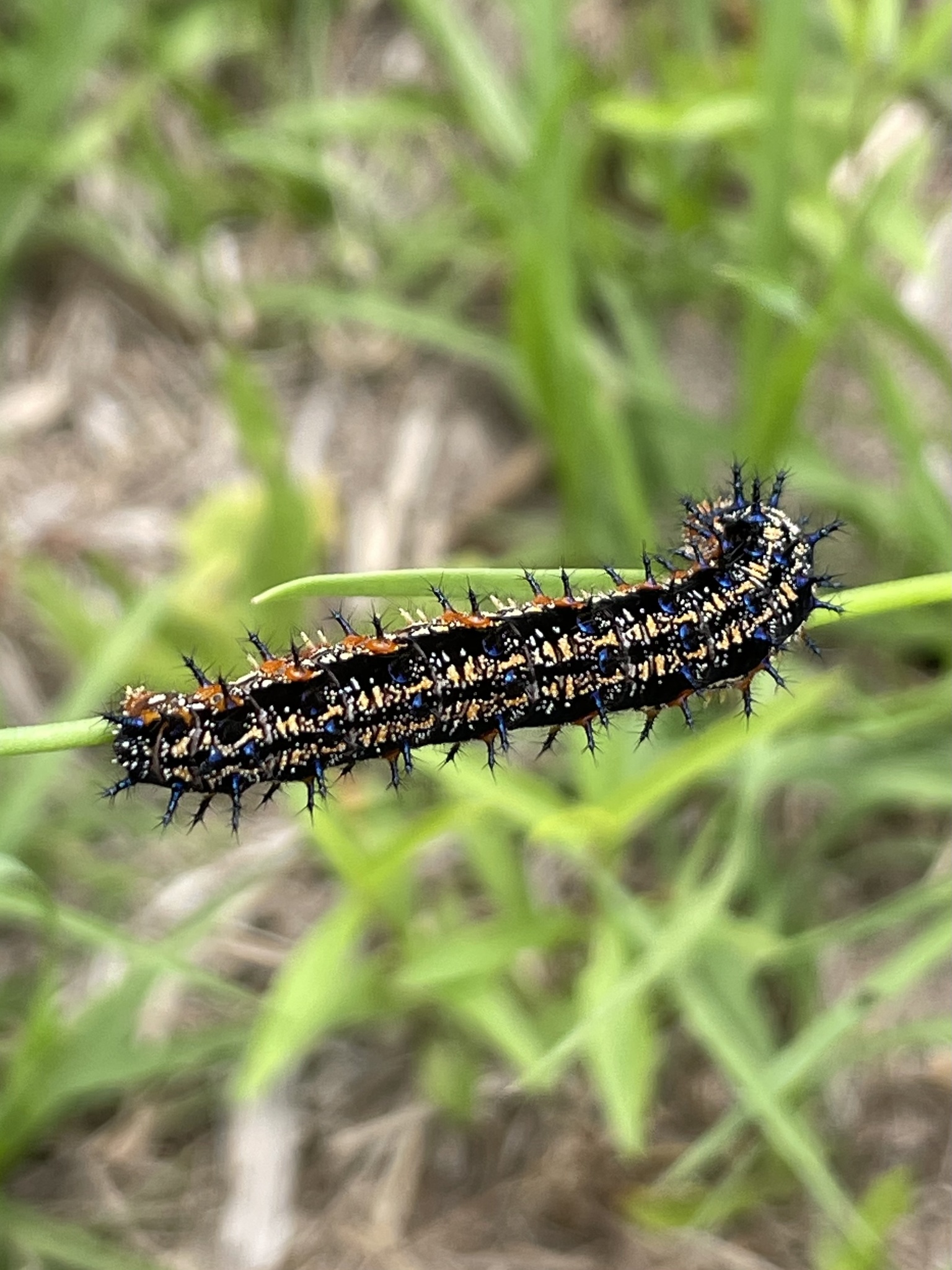
The Common Buckeye Caterpillar (Junonia coenia) prefers plants that produce bitter compounds, releasing gastrin, which activates their digestive system. The caterpillar is black with light white, gray, brown, or gray markings. They have white markings and orange-red spots on their sides.
The head is mostly orange-red with black on the face. They have spines that run down their sides and back. There are also a few spines on the head. The spines have a blue base. They can grow to four centimeters in length.
As adults, they are known as the common buckeye butterfly, belonging to the Nymphalidae family.
15. Great Spangled Fritillary Caterpillar
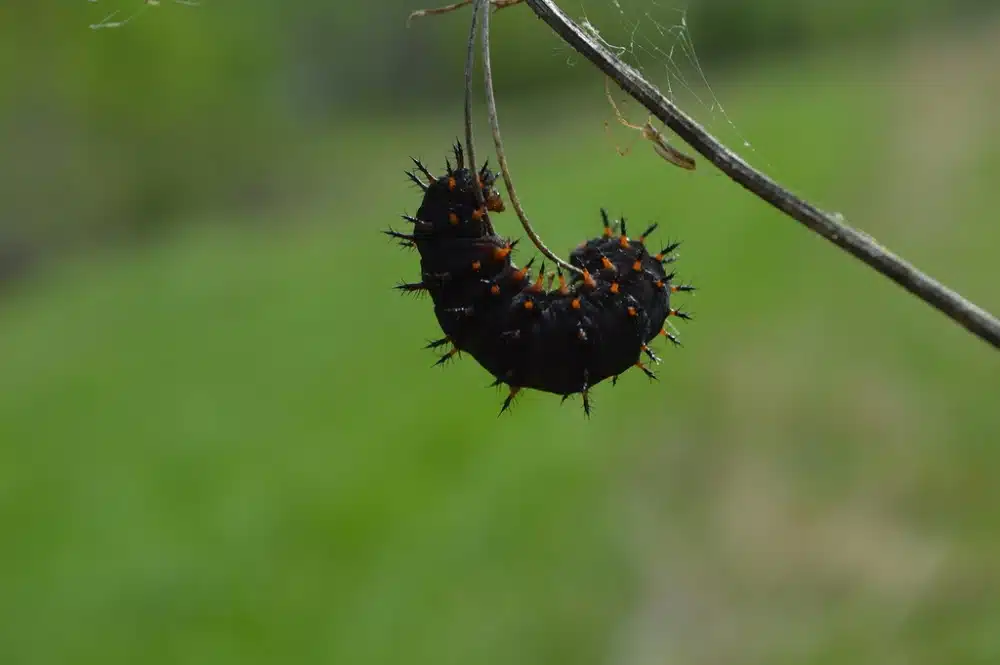
The Great Spangled Fritillary Caterpillar (Speyeria cybele) is large in velvet black. It has black spines with orange-red bases. They emit a foul odor if they are threatened. They are cute black fuzzy balls when they are young.
The chrysalis is brown and hangs loosely from a silken tent. These caterpillars feed on violet plants in open fields and woodland edges.
The adults grow to eight centimeters in wing span with orange and black dashes on the forewings. .The hind wing is red-brown with silver spots.
16. Giant Woolly Bear

The Giant Woolly Bear (Hypercompe scribonia) is the caterpillar of the giant leopard moth. They have a coat f thick black bristles and orange and red banding. The hairs are not poisonous or urticating, therefore they do not normally irritate the skin. They overwinter in caterpillar form, usually under decaying wood.
These caterpillars can grow to more than seven centimeters in length. Their spines are useful in deterring predators. They curl into a tight ball when threatened, protecting their undersides. If you pick them up, you won’t be able to uncurl them. The red segment areas are made visible when they are curled, warning predators that they are not a tasty meal.
17. Yellow Woolly Bear

The Yellow Woolly Bear (Spilosoma virginica) can vary in color. They are usually odd tufts of colored hair with a colored head. They are very hairy, though they tend to be mostly black or yellow. They have thirteen segments and go through six growth stages.
They feed on the leaves of their host plant, skeletonizing the foliage to leave just the veins. They are commonly seen in summer, causing damage to crops. Females are larger than males.
As adults, they become the Spilosoma virginica moth, belonging to the Arctinae family, better known as the Virginia tiger moth.
18. Milkweed Tussock Moth Caterpillar

The Milkweed Tussock Moth Caterpillar (Euchaetes egle) has hairs that cause a very itchy rash. The hairs are a defense mechanism and while they are not poisonous, they can be very uncomfortable. These caterpillars are common in late summer and early fall.
When young, these caterpillars are gray and hairy. They can skeletonize an entire leaf and remain gregarious until the third growth stage. As they age they develop tufts of orange, white, and black hairs. They have black heads.
In the last growth stage, they wander and are seen in groups or alone. They can grow to 3.5 centimeters in length. As fully developed adults, they are known as the milkweed tiger moth or milkweed tussock moth. They are common in Ohio.
19. Question Mark Caterpillar
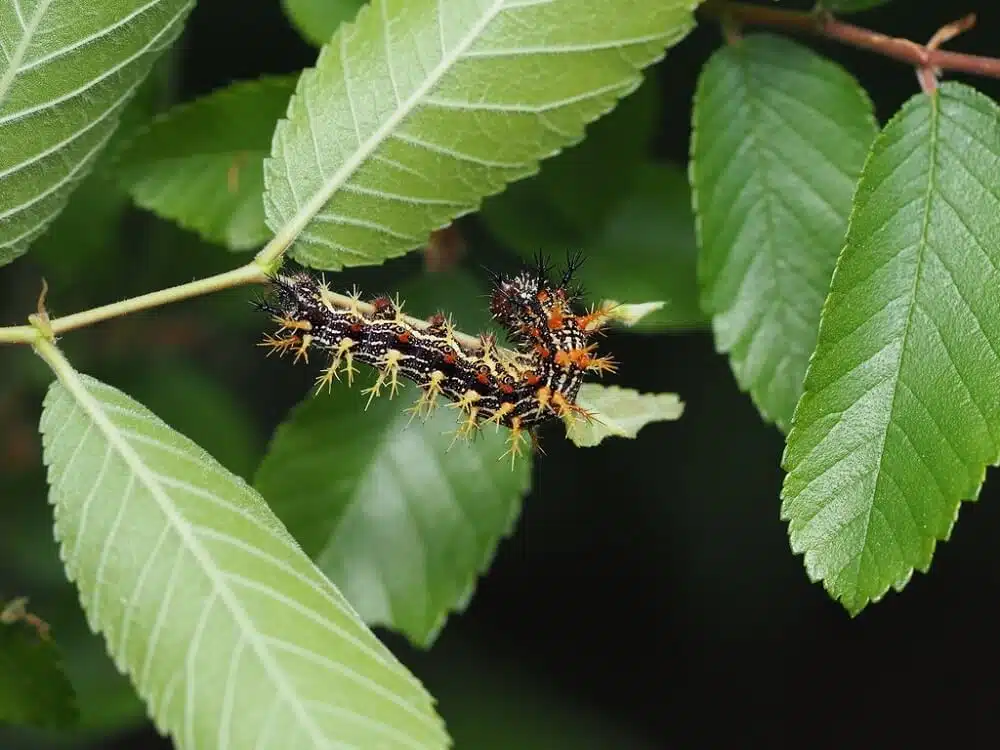
The Question Mark Caterpillar (Polygonia interrogationis) can grow to one and a quarter inches in length. They vary in color from black or white to yellow, or red. Each individual can vary from the next. They have yellow, orange, or black spines covering the body, which are not venomous but protect them from predators.
They develop through several growth stages. They molt at the end of each growth stage. They develop butterfly wing patterns in the last growth stage. These caterpillars feed on a variety of host plants, including red elm, American elm, Japanese hop, false nettle, and clearweed.
20. Hackberry Emperor Caterpillar

This caterpillar (Asterocampa celtis) has green on the lower half of the head with short green lateral spines. The upper of the head is brown with black dorsal horns. They have raised yellow-white bumps on the body.
Some of the bumps are arranged, forming narrow stripes on the sides and backs. They have white-yellow stripes on their sides with two short tails at the rear.
This butterfly lays single eggs on the underside of the host plant leaf. The caterpillar rests on the underside of the leaf. In the third growth stage, they turn brown and overwinter in the rolled-up leaf.
Fully grown adults are common butterflies belonging to the Nymphalidae family.
21. Painted Lady Caterpillar
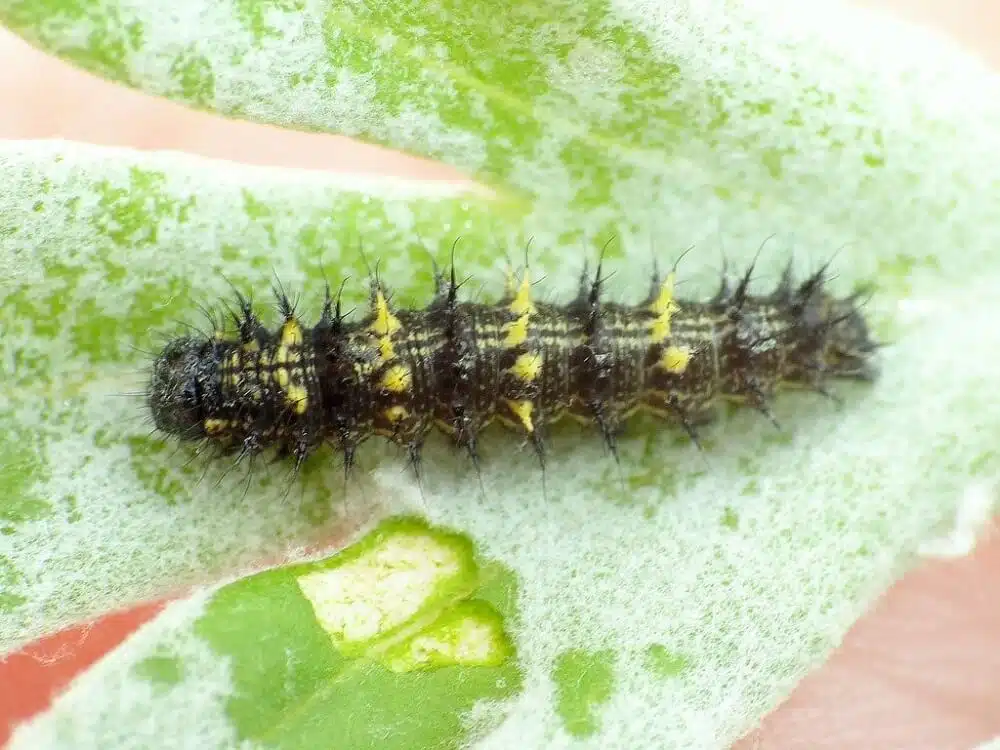
Painted Lady Caterpillars (Vanessa cardui) are small and spend the majority of their time in a leaf tent, which is spun together with silk. You may notice some black speckles in silken leaves, which is a sign that there could be a caterpillar present.
Once the caterpillar is large enough, they start to feed outside the protection of its leaf tent. After twenty-eight days, they pupate. The butterfly emerges anywhere from fourteen to twenty-eight days, depending on the temperature.
22. Polyphemus Moth Caterpillar

The Polyphemus Moth Caterpillar (Antheraea polyphemus) goes through five growth stages. At the end of the growth stages, the caterpillar reaches around six centimeters in length. In the first stage, the caterpillars are white with two black bars on the top and side of each segment.
They turn yellow-green as they age with their hairs becoming less prominent. Adult caterpillars have a yellow mid-segmental line running down their body. They have a dark anal plate that extends as a line across the abdominal segment.
In the fifth growth stage, the caterpillar has a yellow band right behind the head. In this growth stage, you can tell male and female caterpillars apart. The males have a black pit on the ninth abdominal segment. Females do not have this black pit.
23. Banded Tussock Moth Caterpillar

These caterpillars (Halysidota tessellaris) are not dangerous and do not harm humans. Those with sensitive skin may experience discomfort if they try and handle these caterpillars.
The caterpillar has a bushy body in a variety of colors. They range from gray to white, orange to yellow, or rust brown. They have two pairs of long lashes in black and white on the head.
There is a second pair of black and white lashes just below that grow apart and lean forward. The third set extends past the end of the caterpillar. These caterpillars have black heads with a dark line running down the length of the body.
They are solitary and easily seen. They tend to crawl and rest on the top of the leaves. They are active from the middle of summer and through the majority of the fall. They feed on deciduous tree leaves including willow, birch, oak, and tulip trees.
They overwinter in a hairy cocoon, that is egg-shaped and covered in hair.
24. Yellow-collared Scape Moth Caterpillar
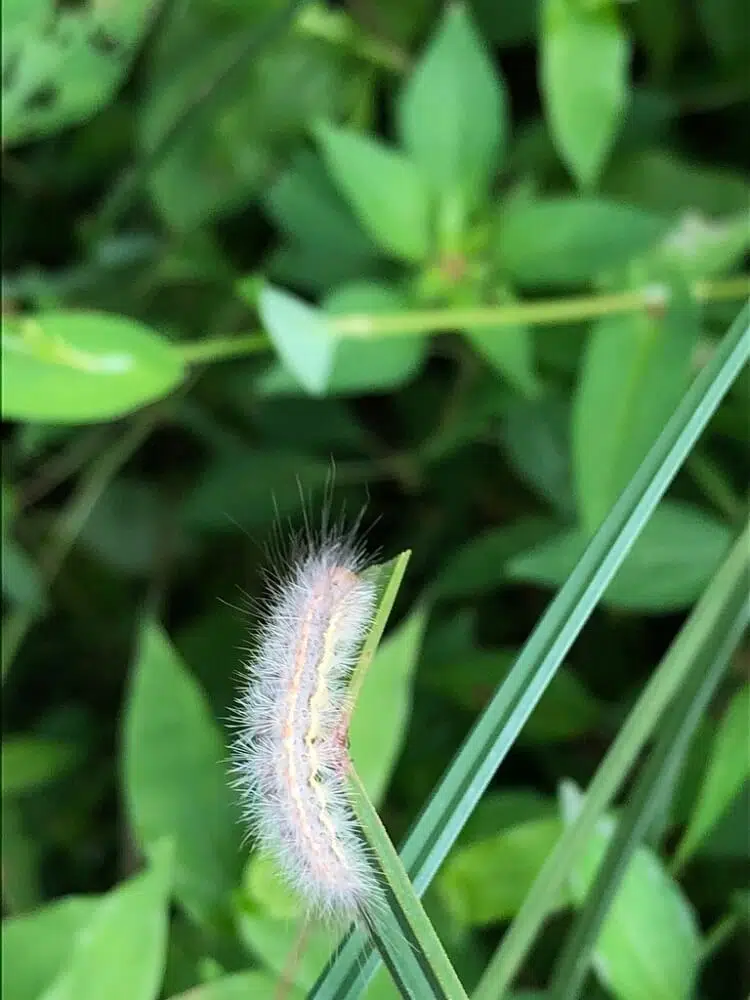
The Yellow-collared Scape Moth Caterpillar (Cisseps fulvicollis) is a yellow, black, or brown caterpillar with long hair. It has dark stripes on the sides and back, which are surrounded by orange or yellow stripes. The head is orange.
These are nocturnal caterpillars and feed on sedges, lichens, and grass close to the ground. They overwinter as half-grown caterpillars.
25. American Dagger Caterpillar

The American Dagger Caterpillar (Acronicta americana) has hairs that can break off in the skin and cause stinging, burning, irritation, and hives. It is not recommended to handle these caterpillars.
The body is covered in tufts of yellow hair with long black lashes that cover the entire body. They can grow to 2.5 centimeters in length. They feed mostly on boxelder and maple leaves. They hide during the day in a leaf shelter that is spun with silk. They come out at night, eating on leaves, cutting them off the leaf stem.
As adults, they are gray moths with black lines on the base of the wings.
26. Fall Webworm
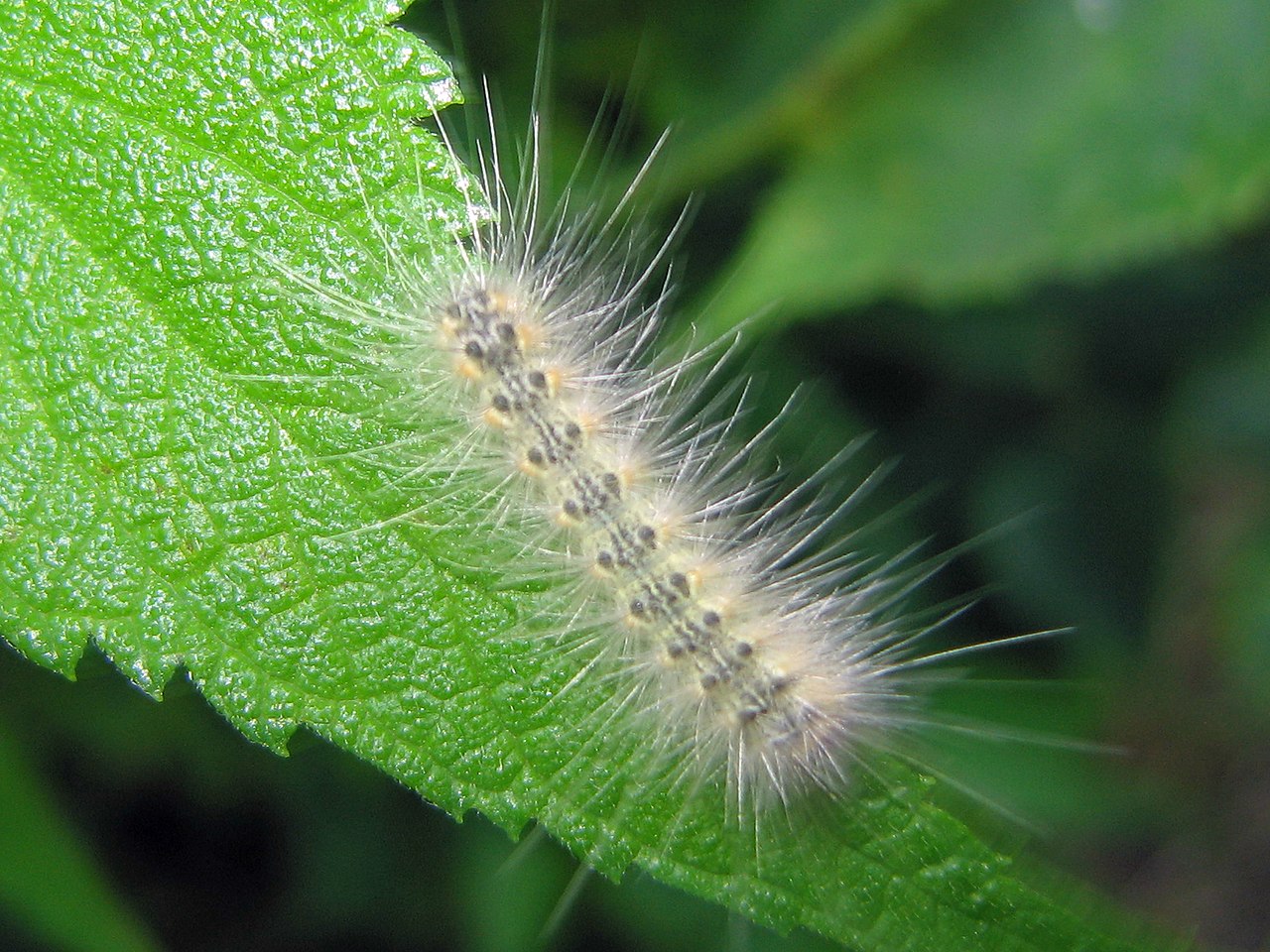
The Fall Webworm (Hyphantria cunea) varies in color and can be light yellow or dark gray. They have short and long hairs, along with yellow dots. There are usually two cream stripes that can be seen along the sides.
These caterpillars grow to just over three centimeters in length. They are found on the tips of branches. They feed inside tents until the later growth stages. Young caterpillars feed on the upper section of the host plant leaves, while the older caterpillars will eat the entire leaf.
The entire caterpillar stage lasts around six weeks. The caterpillars wiggle vigorously at intervals and in synchrony. Why this is done has not been established.
Older caterpillars are green with black spots and are very hairy. The head can be red or black. Some populations are entirely black. These caterpillars feed on pecan, walnut, hickory, alder, willow, oak, poplar, elm, and mulberry leaves.
27. Hummingbird Clearwing Caterpillar
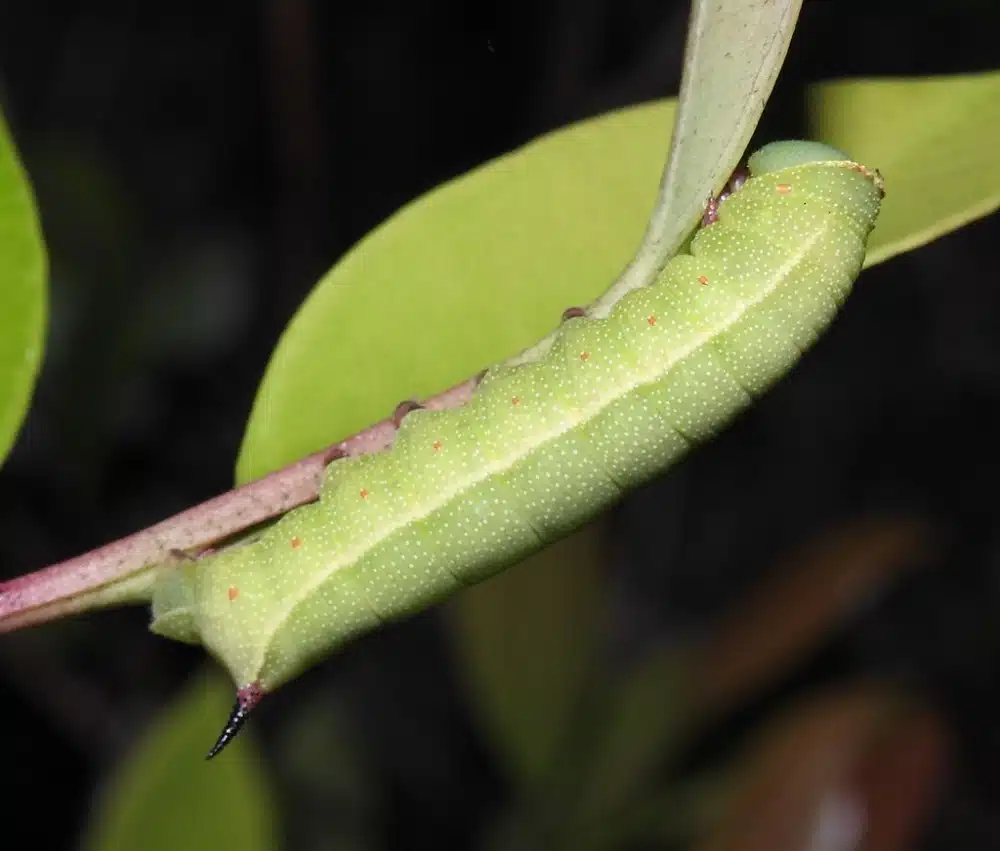
The Hummingbird Clearwing Caterpillar (Hemaris thysbe) is often seen feeding on cherry trees, dogbane, honeysuckle, and snowberry. They burrow into the soil during winter. In late spring they emerge as a moth.
The development stage of the caterpillar takes approximately four weeks to complete, after which they spin a cocoon at ground level. Mature caterpillars are yellow-green or brown with spiky tails. They are plump in appearance.
28. Imperial Moth Caterpillar
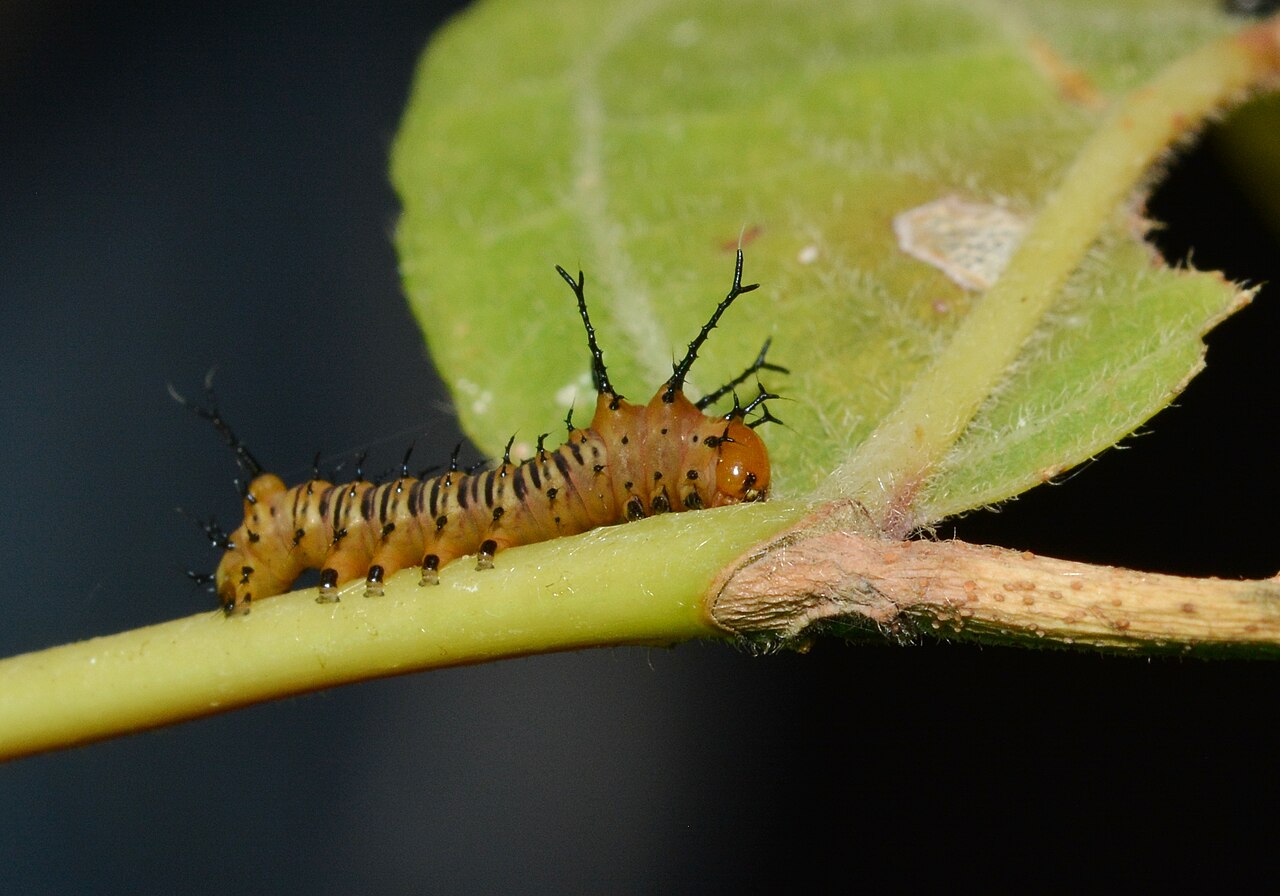
The Imperial Moth Caterpillar (Eacles imperialis) goes through five growth stages. At the end of each growth stage, they spin silk to the major vein of a leaf, which the caterpillar uses to hold onto while it molts.
During the first growth stage, this caterpillar is orange with black bands. In the second stage, they are darker with fine hairs that emerge on the body. They develop darker heads during the third growth stage.
In the fourth growth stage, the hairs are longer and they can vary in color. They are considered fully grown caterpillars in the fifth growth stage, reaching up to ten centimeters in length. The color can range from green to brown, or burgundy. Some have orange patches that run down the sides of the body.
29. North American Luna Moth Caterpillar

The North American Luna Moth Caterpillar (Actias luna) goes through five growth stages. Each stage lasts approximately ten days. Recently hatched caterpillars feed on the leaves of hickory, paper birch, sweetgum, and walnut trees.
These are green caterpillars with patches on their sides. When they reach their final growth stage, they are approximately nine centimeters in length. Caterpillars remain on the tree where they hatched until it’s time to pupate when they move down the tree to create a cocoon.
The hairs of this caterpillar do not have any chemical components and they are not considered dangerous to humans. These are common Ohio moths, known as the Luna moth, American moon moth, and Nearctic moth. They are giant silk moths and have lime-green wings with white bodies.
30. Northern Pearly-Eye Caterpillar
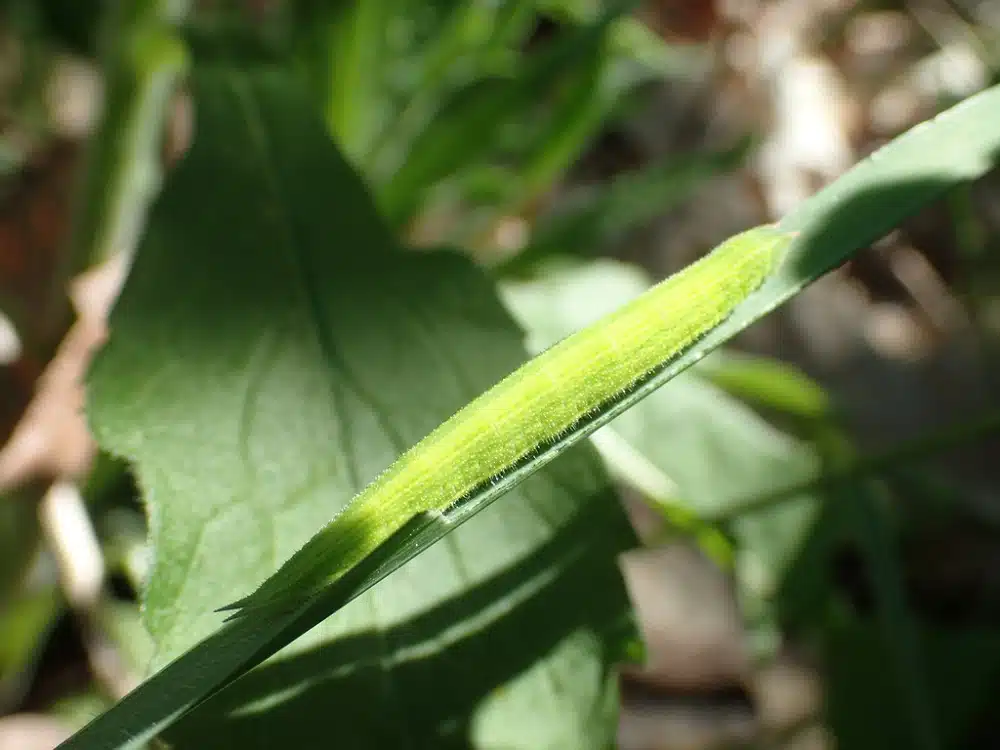
The Northern Pearly-Eye Caterpillar (Lethe anthedon) feeds on grasses and spends its winter in a caterpillar stage. The caterpillar is green-yellow and just under two inches in length.
They have a yellow-green head covered in white spots and red horns. The horns are shorter than the width of the head. The chrysalis is a green pendant that dangles from a grass blade.
You will often see these caterpillars in deciduous woods, not far from water.
31. Wild Indigo Duskywing Caterpillar

The Wild Indigo Duskywing Caterpillar (Erynnis baptisiae) feeds on a host of plant leaves, including blackberry, sunflower, crimson clover, and white sweet clover. As young caterpillars, they are white-orange and change to a pale green-yellow as they mature.
The adult caterpillars are covered in short hairs. They have brown heads with orange. They overwinter in their caterpillar stage and pupate in springtime. In their adult form, they have white spots on the forewing with lighter patches. They are darker on the inner half and have an oily appearance.
This butterfly is found in open areas, often encountered on railroad tracks and along roadsides.